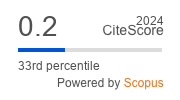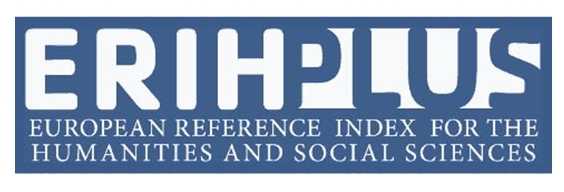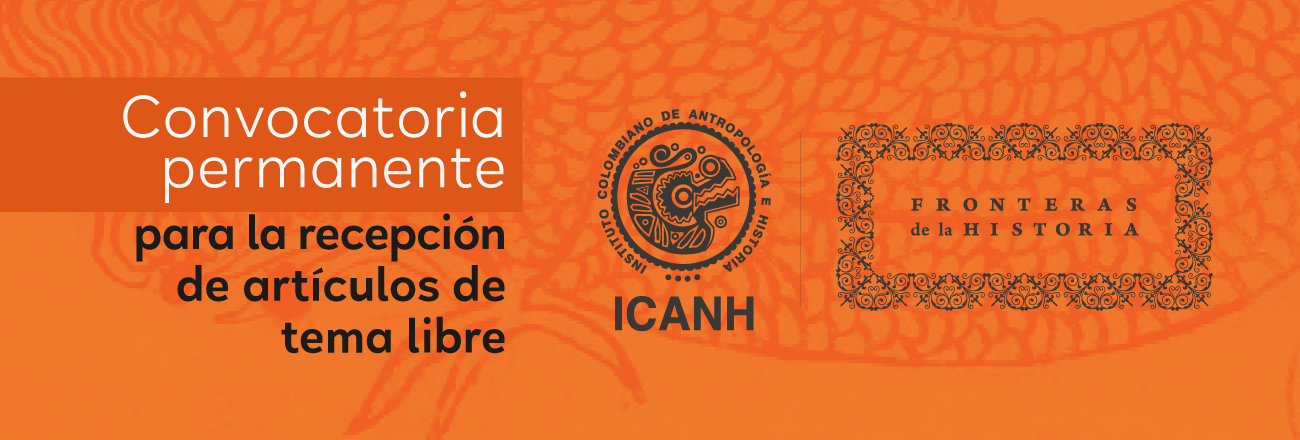Submissions
Submission Preparation Checklist
As part of the submission process, authors are required to check off their submission's compliance with all of the following items, and submissions may be returned to authors that do not adhere to these guidelines.- The submission has not been previously published nor is under simultaneous consideration by any other journal (or the author has informed the journal of this status and has provided an explanation in “Comments to the editor”).
- Whenever possible, URLs are provided for references.
- The text adheres to the journal’s style and reference guidelines as summarized in the Author's Guidelines/a, which appear in About the Journal.
- The text adheres to the principles of transparency and good practice in academic publishing of the Committee on Publication Ethics-COPE (http://publicationethics.org/).
Author Guidelines
1. Submission of manuscripts
All manuscripts must be submitted anonymously: all citations, acknowledgments, references and other data that could directly or indirectly permit the identification of the author must be removed. Submitted manuscripts that do not comply with this rule will be rejected and will not be sent to peer review. When submitting the manuscript through the online platform, identifying information about authorship, funding sources, etc., may be indicated, and the main author of the manuscript is responsible for providing the correct details about the manuscript’s metadata. If the manuscript has been approved for publication, a non-anonymized version will be required for publication. Co-authored articles will be accepted with an upper limit of five authors, while collective authors will not be accepted.
The submission of a manuscript presupposes, on the part of the authors, the acknowledgement and acceptance of these Instructions.
The work must be strictly original and unpublished in any language, and the author is responsible for informing the journal if these criteria are not met. Articles should not be under simultaneous consideration by other journals or editorial bodies, at the time of submission as well as during the peer review process. It is the author’s responsibility to inform the journal regarding all copyright status related to the work. The publication of a work that violates these rights will be the sole responsibility of the author.
The author of the manuscript or the person submitting the manuscript will be responsible for all communication and correspondence with the journal related to the submission. This person will be responsible, in the event of multiple authorship, for contacting their co-authors and for providing, via the platform, necessary information about them, taking responsibility for possible conflicts over the authorship of the manuscript. An explicit request is required to change the corresponding author.
Peer review process: 1. The editorial committee evaluates the manuscript to determine its relevance to the journal’s aims and scope. 2. Articles approved by the editorial committee will then be sent to two external reviewers in a double blind peer review system. This process guarantees the anonymity of both the author(s) of the article and the reviewers. 3. The reviewers submit their evaluations of the article, recommending five possible decisions: Accepted; Accepted with minor revisions; Accepted with major revisions; Revise and resubmit (for articles that have potential, but that require further reorganization); Rejected. 4. When the article has been revised according to the reviewers’ suggestions and resubmitted, it will be reevaluated by the original reviewers or by the editorial committee for its final acceptance or rejection. 5. In the case of a clearly divided opinion between reviewers, the opinion of a third reviewer will be requested, or the editorial committee will make a final decision.
The process of evaluating an article, from the date of its reception to its final acceptance or rejection, will take between 2 and 5 months.
The publication period of an article, from its final acceptance, will take between 3 and 10 months at most.
The pool of reviewers will consist primarily of academics external to the publishing institution.
Autoctonia peer review guideline
2. Language
Articles and documents in Spanish, Portuguese, English and French will be accepted. Book reviews in Spanish, English, French and Portuguese will be accepted.
3. Word limit
-The word count for articles (both for special issues and individual submissions) is a minimum of 5,000 and a maximum of 11,000, including notes and references.
- Documents must not exceed 6,000 words.
- Reviews: 2,000 words maximum.
4. Style guide
Articles and reviews should be uploaded in a text document format (doc, docx) with Calibrí 11, single line spacing, unjustified text. First paragraphs of each section should not be indented.
Footnotes should be numbered, always at the end of the text, and kept to a minimum. Full bibliographic citation should not be given in a footnote. Endnotes are not accepted.
Sections of the manuscript should be numbered and titled in lowercase, bold and Calibrí 11 font.
4.1. Visual sources
All visual sources have to be put in order with correlative Arabic numbers after the word “table”, “graphic”, “image” or “map” (depending on each case). They need to have a brief title que reflects its content and at the foot the source has to be referred, even in case of an own elaboration, in which case you put: “own elaboration”. They have to be embed at the corresponding place within the text. Although they have to be handed in in the original version from the applications that has been used (Photoshop, PowerPoint, Acrobat, Excel, etc.)
4.2 Firm
The order of the authors as it appears in the original sent will be scrupulously respected. Regarding the form of the signatures, the following is recommended, respecting the following order:
a. Names and surnames: Paternal surname-Maternal surname, First name/Middle initial (Carmona-Jiménez, Javiera A.) Compound names (e.g., María del Pilar): the middle name should be included without the connector "del" (Ej: María Pilar). Compound surnames (e.g., del Valle Ortiz, Carlos): join the connector "del" with a hyphen to avoid confusion in the indexing (e.g., del Valle-Ortíz, Carlos A.).
Note: if hyphens are placed before the comma, the indexing rules understand that everything before the comma is part of the surname.
b. Institutional affiliation: (strictly following the following order): Full name of the institution in Spanish (the acronym of the institution should not be used), Subunit, acronym. E.g.: Universidad Bernardo O'Higgins, Centro de Estudios Históricos, CEH; Universidad Bernardo O'Higgins, Facultad de Ciencias Humanas, FCH.
+ e-mail + ORCID (correct format: http://orcid.org/0000-0000-0000-0000).
4.3. Títle
Articles and reviews must be presented with the title in Spanish or portuguese or french and English. Titles with more than twenty words are advised against; they should be informative and faithfully reflect the content of the article. The use of unnecessary words should be avoided, and where possible, the title should include descriptors associated with the author’s area/discipline of expertise. The use of abbreviations, acronyms, symbols and formulas should be avoided.
4.4 Abstract
The articles should be accompanied by an abstract of 150-200 words (10 lines) in Spanish or portuguese or french and English. Its content should be strictly informative and follow the structure of objectives-methods-results-conclusions. Information that does not appear in the main text of the article cannot be included in the abstract. Unnecessary words or expressions and excessively long sentences should be avoided.
4.5 Keywords
A maximum of 5 descriptors or keywords will be included, in Spanish or portuguese or french and English. To encourage standardization, these words should be extracted from standardized thesaurus and dictionaries, including CSA Worldwide Political Science Abstracts Thesaurus and the International Bibliography of the Social Sciences (IBBS) Thesaurus. Keywords always in lower case - except for proper nouns - separated by a comma (e.g. word 1, word 2, word 3, word 4, word 5).
4.6 Acknowledgments
In the case of including acknowledgements, these should be included at the end of the paper. Their length should not exceed 100 words. Any type of document published in Autoctonia, associated with projects financed by ANID or by private institutions, national or foreign, must register the acknowledgement to this institution and its corresponding instruments in the following way: Funding Agency/instrument code/project code, e.g.: ANID/FONDECYT/ REGULAR Nº 1220626. If the funding source includes more than one project, the above example should be replicated for each fund.
4.7 Footnotes
Footnotes should be kept to a minimum, always at the end of the text. Any references cited in notes should be included in the bibliographic reference list. To insert a note, the numeral of the note must follow a full stop, a comma or a semicolon.
4.8 Bibliographic references
The bibliographical references will appear within the text, but never as footnotes. In case of direct quotes, these will be enclosed in angle quotes, also called Latin or Spanish («... »), don’t use italic letters for this. If the quote is longer than 40 words, it has to be put in a separate paragraph, using margins of 2,5 cm; in this case, no quotations marks will be used.
In case of quotes within the text (direct or indirect), the Harvard author-year system will be used (author, year: page): (Dahl, 1989: 323).
Sources with two authors are cited with their first surnames and joined with “y: (Newton y Norris, 2000)
(Telles y Ortiz, 2011)
Sources with three or more authors can be cited using the first surname of the first author followed by et al.:
(Amador et al., 1989)
If multiple works of a single author or authors published in the same year are cited, a, b, c, should be added after the year of publication:
(Franzen, 2012b)
When the work of various authors is cited in the same sentence, the references should be separated with a semi-colon (;)
(Bourdieu, 2001; Harvey, 2013)
When the surname of a cited author appears as part of the text, the year published of the reference cited should appear always in parenthesis.
As Goldthorpe (2010) argues…
Each in-text reference should correspond to a full reference in the bibliography at the end of the main text.
Self-citation should be avoided or restricted unless necessary.
4.9. Employed references
This should be included at the end of the article. It should only contain references that have been cited in the main text. It is strictly forbidden to include any other references. The editorial team will eliminate all the references from the bibliographical list which are not quoted within the text. Authors should be ordered alphabetically by their last names. Referencing style should adhere to the following guidelines:
a. Last name(s), N.
In the event of multiple authors, the authors’ names should be separated by commas, except where the last co-author will be added with an “y”. From the second author onwards, the name should be written in direct order: name (only the initial), last name. In the case where the work has various unspecified authors, use VV. AA.
Sageman, M. y B. Hoffman (2008): “Does Osama still call the shots? Debating the containment of al Qaeda’s leadership”, Foreign Affairs, 87 (4), pp. 163-166.
VV.AA. (2003): Introducción a la economía y administración de empresas, Madrid, Ediciones Pirámide.
b. When various works of the same author appears in the references, these are to be ordered chronologically, beginning from the oldest work. The last and first name should always appear the same.
Navarro, C. J. (2000): “El sesgo participativo. Introducción a la teoría empírica de la democracia participativa”, Papers, 61, pp. 11-37.
Navarro, C. J. (2002): Democracia asociativa y oportunismo político, Valencia, Tirant lo Blanch.
c. The year of publication should include a, b, c, etc. if the reference list includes more than one work of the same author or authors published in the same year (e.g.: 2008a, 2008b, etc.).
Rancière, J. (2006a): “Diez tesis sobre la política”, en Política, policía, democracia, Santiago de Chile, Ediciones Lom.
Rancière, J. (2006b): “Política, identificación, subjetivación”, en Política, policía, democracia, Santiago de Chile, Ediciones Lom.
The following are examples of most commonly cited types of sources. Download the complete Harvard regulations here;
- Journal articles
Enders, W. y T. Sandler (1993): “The effectiveness of antiterrorism policies: a vector-autoregression-intervention analysis”, American Political Science Review, 87(4), pp. 829-844.
- Books
Dahl, R. A. (1999): La democracia. Una guía para los ciudadanos, Madrid, Taurus.
- Partes de monografías
Wildavsky, A. (1989): “A cultural theory of leadership”, en B. D. Jones, ed., Leadership and politics: new perspectives in Political Science, Lawrence, Kansas University Press, pp. 163-164
- Conference papers or papers published as part of conference proceedings
Boundi Boundi, M. (2008): “Marruecos: estructuras sociales y tendencias de consumo en una sociedad en transición”, en Sociedad, consumo y sostenibilidad. Actas del XIII Congreso Nacional de Sociología en Castilla-La Mancha, Toledo, Asociación Castellano-Manchega de Sociología.
- Unpublished tesis
Galais, C. (2008): ¿Socialización o contexto? La implicación política subjetiva de los españoles (1985-2006), Tesis doctoral inédita, Universidat Pompeu Fabra, Barcelona.
- Website references
Green, M. C., J. A. Krosnick y A. L. Holbrook (2001): The survey response process in telephone and face-to-face surveys. Differences in respondent satisficing and social desirability response bias. Disponible en web:
http://www.Clas.ufl.edu/users/kenwald(pos6757/spring02/tch62.pdf [Consulta: 21 de septiembre de 2010]
Where available, the DOI of cited articles or works that have a DOI should be included in the references.
Eg: Last names, Initial. (Year): Title of work http://dx.doi.org/xxxx
-Sources:
Historical archives
Archive. Collection, Section, File, Document, Year, “Document Title" (if applies)
Examples:
Archivo Histórico de la Provincia de Córdoba. Escribanía 2, File 582, Document 18, 1862.
Archivo Histórico Provincial Ricardo Levene. Juzgado del Crimen. Document 446/ 1, 1892. “Ripoll, Antonio. Sospechas de infanticidio. Olavarría. Departamento Judicial Capital”.
- Norms and Legislations
Place. Regulatory rang number/year, norm title. Publication title. Enactment date, pp. (if applies).
Examples:
Chile. Law 1552/1902, Aprueba el Código de Procedimiento Civil. Ley Chile, 30 of August 1902. Available under: http://bcn.cl/2f8h4
Spain. Ley Orgánica 9/2011, de derechos y deberes de los miembros de las Fuerzas Armadas. Boletín Oficial del Estado, 28 of July 2011, 180, pp.85320-85345.
Statistics
Author (year): Title. Editor, compiler o publishing entity.
Examples:
Instituto Nacional de Estadísticas, INE (2018): Radiografía de género: pueblos originarios de en Chile 2017. Unidad de estudios y estadísticas del INE. Available under: https://ine.cl/docs/default-source/genero/documentos-de-an%C3%A1lisis/documentos/radiografia-de-genero-pueblos-originarios-chile2017.pdf?sfvrsn=7cecf389_8
5. Template Word-Publication Format
Documents
Texts of testimonial value
Book reviews
Review and critical analysis writings of a recent academic publication in the social sciences and humanities area. In this case the texts will be revised only by the editorial committee for its approval and inclusion in the journal.
Copyright Notice

Esta obra está bajo licencia internacional Creative Commons Reconocimiento-NoComercial-CompartirIgual 4.0.
Privacy Statement
The names and email addresses introduced to the journal will be exclusively used for the sake of the established means and will not be handed over to third parties nor used for other means.








_18.09_.00_1.png)


















